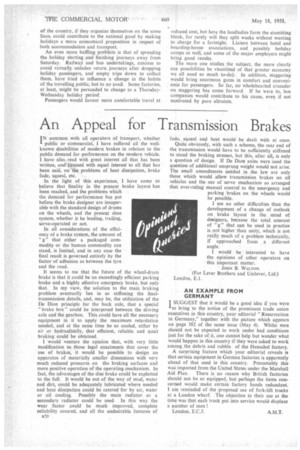An Appeal for Transmission Brakes
Page 54

If you've noticed an error in this article please click here to report it so we can fix it.
IN common with all operators of transport, whether public or commercial, I have suffered all the wellknown disabilities of modern brakes in relation to the public demand for performance on the modern vehicle. I have also read with great interest all that has been written, and listened with equal interest to all that has been said, on 'ffic problems of heat dissipation, brake fade, squeal, etc.
In the light of this experience, I have come to believe that finality in the present brake layout has been reached, and the problems which the demand for performance has put before the brake designer are insuperable with the standard design of drums on the wheels, and the present shoe system, whether it be leading, trailing, servo-operated or not.
In all considerations of the efficiency of a brake system, the amount of "g" that either a packaged commodity or the human commodity can stand, is limited, and in any case the final result is governed entirely by the factor of adhesion as between the tyre and the road.
It seems to me that the future of the wheel-drum brake is that it could be an exceedingly efficient parking brake and a highly effective emergency brake, but only that. In my view, the solution to the main braking problem eventually lies in so stiffening the finaltransmission details, and, may be, the utilization of the De Dion principle for the back axle, that a special "brake box" could be interposed between the driving axle and the gearbox. This could have all the necessary equipment in it to apply the maximum retardation needed, and at the same time be so cooled, either by air or hydraulically, that efficient, reliable and quiet braking could be obtained.
I would venture the opinion that, with very little modification to those legal enactments that cover the use of brakes, it would be possible to design an apparatus of materially smaller dimensions with very much reduced pressures on the braking surfaces and more positive operation of the operating mechanism. In fact, the advantages of the disc brake could be exploited to the full. It would be out.of the way of mud, water and dirt, could be adequately lubricated where needed and heat dissipation could be catered .for by air, water or oil cooling. Possibly the main radiator or a secondary radiator could be used In this way the wear factor could be much improved, complete reliability assured, and all the undesirable features of
820 fade, squeal and heat would be dealt with at once.
Quite obviously, with such a scheme, the rear end of the transmission would have to be sufficiently stiffened to stand the braking stresses, but this, after all, is only a question of design. If De Dion axles were used the question of additional unsprung weight would not arise. The small amendments needed in the law are only those which would allow transmission brakes on all . vehicles and the use of servo mechanism so arranged that over-riding manual control to the emergency and parking brakes on the wheels would be possible.
I see no other difficulties than the development of a change of outlook on brake layout in the mind of designers, because the total amount of "g" that can be used in practice is not higher than unity, which is not really much of a problem technically, if approached from a different angle.
I would be interested to have the opinions of other operators on this important matter.
JOHN B. WALTON, (For Lever Brothers and Unilever, Ltd.) London, £.1.
AN EXAMPLE FROM GERMANY
I SUGGEST that it would be a good idea if you were
to bring 'to the notice of the prominent trade union executives in this country, your editorial "Resurrection in Germany," together with the picture which appears on page 382 of the same issue (May 4). Whilst men should not be expected to work under bad conditions just for the sake of it, one cannot help but wonder what would happen in this country if they were asked to work among.the debris and rubble of the Henschel factory.
A surprising feature which your editorial reveals is that certain equipment in German factories is apparently ahead of that used in this country. Presumably this was imported from the United States under the Marshall Aid Plan. There is no reason why British factories should not be so equipped, but perhaps the items concerned would make certain factory hands redundant. I am reminded of the proposed use of fork-lift trucks at a London wharf. The objection to their use at the time was that each truck put into service would displace a number of men !
London, E.C.3.




























































































